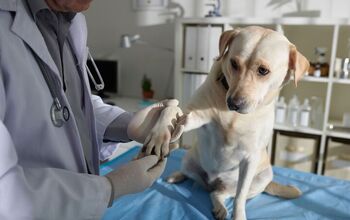5 Common Pet Food Ingredients That Could Harm Your Dog

We all know there’s little that dogs wouldn’t eat. But just because they wouldn’t mind eating a month-old Dorito they found behind the sofa, it doesn’t mean that they should.
When it comes to choosing food for your pet, you should follow the same principle. No matter how yummy your pooch thinks a particular brand of kibble is before you make it a part of their regular menu, you need to check for any potential red flags. Written in the tiniest of fonts and hidden among seemingly indecipherable words, lurk pet food ingredients that could wreak havoc on your pet’s health.
Without double-checking everything that goes into your furball’s bowl, you can’t be sure they’re getting what they need. Even the super-premium brands can contain preservatives, flavor enhancers, or dubious protein sources that have been linked to various serious illnesses.
Here are the five most common and dangerous ingredients in pet food you should watch out for:
Ethoxyquin
Used as a preservative for pet food, ethoxyquin also doubles as a pesticide. (Because nothing says yum like a scoop of chemicals that prevent pear disease!) While it won’t downright poison your pooch, this Monsanto-produced antioxidant has been linked to liver and kidney damage, allergies, and even cancer.
After safety concerns were raised regarding the adverse effects of ethoxyquin on dogs, the FDA requested that the industry voluntarily reduce the amount included in dog food formulations. But there were no laws or regulations passed to force manufacturers to comply. Most brands, focusing on the well-being of the dogs that they are feeding, did follow through with this request. Unfortunately, there are some that refused to make a chance and continue to use the preservative as they were previously.
Watch out when you check the labels because this preservative can also be labeled as just E- sneaky, right?
BHA and BHT
Often appearing together, BHA and BHT are used as synthetic sources of vitamin E or preservatives. Although there hasn’t been any proof that small doses of these substances are harmful, studies on prolonged consumption are quite worrisome. Both BHA and BHT are recognized by the FDA as known carcinogens, and they’re suspected of causing damage to the nervous system, liver, and GI tract.
Some brands will argue that the use of BHA and BHT in dog foods is safe due to the fact that the FDA has approved it for use in human foods in limited amounts. But there are many foods and ingredients that are safe for humans to consume while being considered toxic for dogs. For example, foods like grapes, avocado, onions, and the sugar substitute xylitol can all be life-threatening for dogs if consumed. Being approved by the FDA for human consumption does not mean that something is safe for a dog to eat.
These vitamin E substitutes can also be listed as Butylated Hydroxyanisole and Butylated Hydroxytoluene.
Carrageenan
If you’re giving your pet canned food, there is a 70% chance that it contains this additive. It is used to give the food a jelly-like consistency that we are used to seeing when opening a can of food. Even though it’s derived from red seaweed, which makes it sound like a natural ingredient, carrageenan is anything but healthy. In fact, new evidence has revealed your dog won’t metabolize this ingredient. Instead, it passes through impacting the digestive system on the way which often leads to the development of diarrhea or soft stool.
Studies have linked this wet food thickener with malignant tumors, gastrointestinal inflammation, and cancerous lesions in the intestines. While this ingredient is still commonly seen in many wet foods, awareness of the risks is growing. As more companies discover the potential dangers of this ingredient, there are more carrageenan-free products entering the marketplace.
Meat By-products
Even though this ingredient is not as scary-sounding as some of the others on this list, it can be the most dangerous one. A protein source for many commercial pet foods, by-products of the slaughter industry are, basically, every part of the animal that doesn’t go into human-grade products. For example, poultry by-products are mostly beaks and feathers; beef by-products can be hooves and horns, and so on.
Besides not having any real nutritional value, animal byproducts can contain some seriously harmful substances. There have often been pet food recalls because of a dangerous component that sneaked its way to kibble or wet food through animal by-products, such as traces of euthanasia drugs, bacteria, or fungus. Byproducts can sometimes be labeled as animal fat, bone, blood, or meat meal, so make sure to be careful when checking the ingredient list.
High-Starch Grains
There has been a significant debate in recent years regarding the benefits versus the risks of a grain-free diet. An announcement in July 2018 from the FDA revealed that they were investigating a potential connection between dog foods labeled as “grain-free” and reports of canine dilated cardiomyopathy (DCM). Since that time, further research has redirected the focus from all grain-free foods to specifically those with pea or lentils used as a grain substitute.
This has revised the view of grains, with grain-free foods only being recommended for those who have developed an allergy or intolerance to these ingredients.
But not all grains are created equally! There are some grains that contain high levels of highly digestible starches that should be avoided. When these starches break down, your dog will experience a sudden spike in his blood sugar levels. If a dog continues to eat these foods and experiences these rapid blood sugar swings, it can lead to the development of diabetes.
How to Keep Your Dog Safe
Every pet owner just wants what’s best for their pet, and a wholesome diet is the foundation of a long and happy life. The most important thing you can do to keep your dog safe is to carefully read all ingredient lists before allowing your dog to consume dog food or treats. Search for foods that contain highly nutritional and healthy ingredients like high-quality animal proteins.
Navigating through complicated labels might seem like a lot of work, but opting for healthier options and ditching those dubious foods can only benefit your furry best friend. If you are unsure about the quality of your dog’s food or searching for some guidance on what to look for, talk to your veterinarian or a professional nutritionist.

A proud mama to seven dogs and ten cats, Angela spends her days writing for her fellow pet parents and pampering her furballs, all of whom are rescues. When she's not gushing over her adorable cats or playing with her dogs, she can be found curled up with a good fantasy book.
More by Angela Vuckovic























